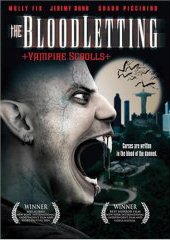
A chief archetypal figure of fear, the vampire has long been a mainstay of horror fiction and cinema. The undead has always occupied a special if berated position in the pantheon of fright figures, reflecting in its evolution our changing cultural fears and desires, our norms and taboos. Representative of our human fear of, and fascination with, mortality (and a hoped for afterlife), the vampire embodies/represents our tragic and paradoxical attraction for violence/power on both a literal and metaphorical level. A far cry from the undead of ancient oral folk tales, the modern celluloid vampire almost always disguises his lecherous intent beneath an attractive 'bad-boy' guise. Besides suggesting a deeper philosophical context, namely the falseness/dangers of exterior appearances, this dual nature -- the sexual appeal of the hoary undead -- points to the relationship between beauty and decay, sex and death. Enticing while they repulse, scaring and seducing with equal ease, they have become too familiar with audiences, exploited to such an extent that the mystery they once embodied has been replaced by dulling over familiarity.
While the classic vampire movies, from Tod Browning's Dracula to Terence Fisher's Hammer films, cloaked the creature's erotic tendencies beneath atmospheric subtlety, the 60s and 70s saw the rise of a bold new approach. Crossing thresholds of taste and expectation, such films as Daughters of Darkness and Vampyres explored the sexual nature of vampirism, and the sado-masochistic nature of the victim/victimizer relationship, with graphic explicitness and surrealistic style. This energetic revision lost much of its appeal in the 90s as the swinging undead of Anne Rice's novels and a god-awful storm of angst-riddled imitators followed suite. Suddenly, the undead weren't corrupt, stinking corpses dropping meat from bone, but handsome playboys pontificating about the hardships of un-life at Goth clubs! The Bloodletting Scrolls, the newest cinematic nail in this trope's coffin, is neither as stylistic as its European predecessors nor as hip as Rice's dopey-eyed variations. An extremely low budget effort, this film lacks both the essential ideas and visuals required for a film to be truly involving. While several distinct scenes invite interest, the story as a whole fails to evoke either awe or terror -- two musts for any feature, particularly a genre film.
The plot for The Bloodletting is its major failing, for surprisingly well handled fight scenes, ample blood spilling, and attractive young people are a poor substitute for theme and meaning. While these elements lend visual polish to the lackluster proceedings, it comes across as little more than window dressing due to the plot's essential lack of complexity or character. Bringing out a tired vampire cliché for one more midnight ramble, this film focuses on a group of college students who ignore a mysterious homeless man's warnings that doom is coming their way . . . Of course no one believes him, and of course they live (or not) to regret it. On their way home during the evening, one of the co-eds vanish, leaving the surviving friends no clues as to where she might be. When the missing girl finally finds them, she's no longer the gal they remember . . .
Said to have been written in nine days, shot by a small crew, The Bloodletting is remarkable as a product of grass-roots, down and dirty low budget filmmaking -- but not as a story. While it is remarkable such a limited cast/crew achieved as much as they did against such constraints of time, budget, and experience, this can't make up for the fact that the movie depends on one cliché after another to move forward its over-simplistic plot, nor the fact that we're never truly invited to care about what happens. Characters come across as caricatures, resorting to type instead of being allowed to grow. The premise of a vampire lusting after/changing a female victim and the resulting dynamics/struggles the new vampire must face is a scenario which long ago lost any real ability to frighten, unable to arouse interest or sympathy. In those rare instances when such simplistic plots do satisfy, they do so as a result of superior stylization or character development, neither of which this routine outing offers. Well intentioned but poorly made, this is a foppishly structured, poorly shot horror film without any true aesthetic purpose or scares to speak of.
A bare bones Disc, The Bloodletting is featured in Full Screen with Dolby Digital 2.0 for sound.
Review by William P. Simmons
| Released by Anchor Bay |
| Region 1 - NTSC |
| Not Rated |
| Extras : see main review |